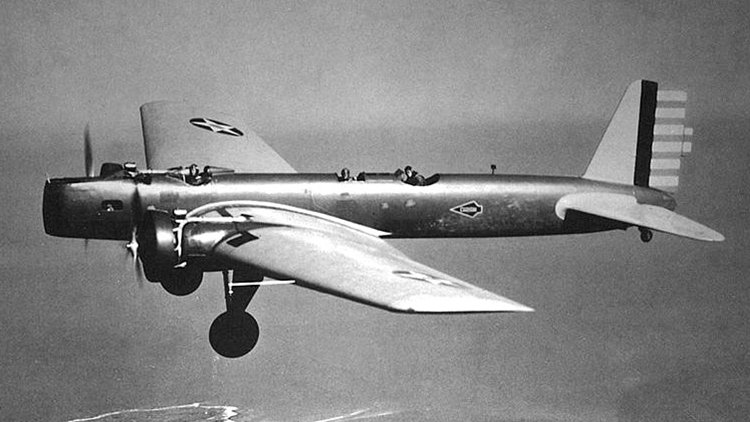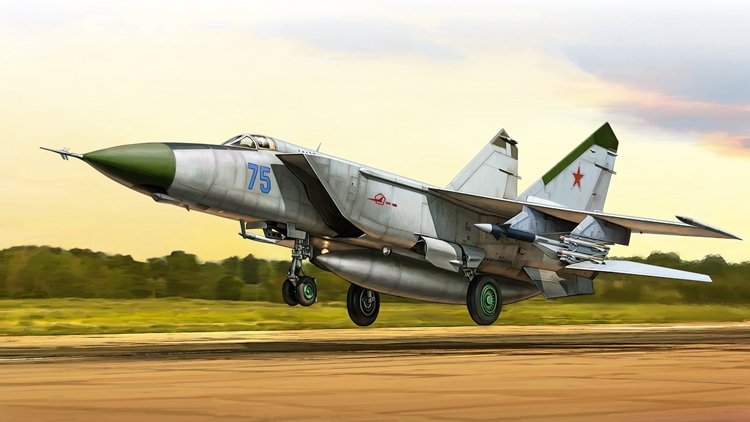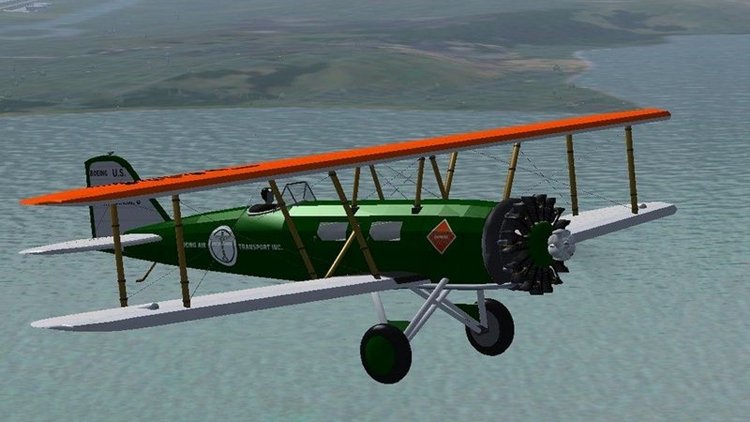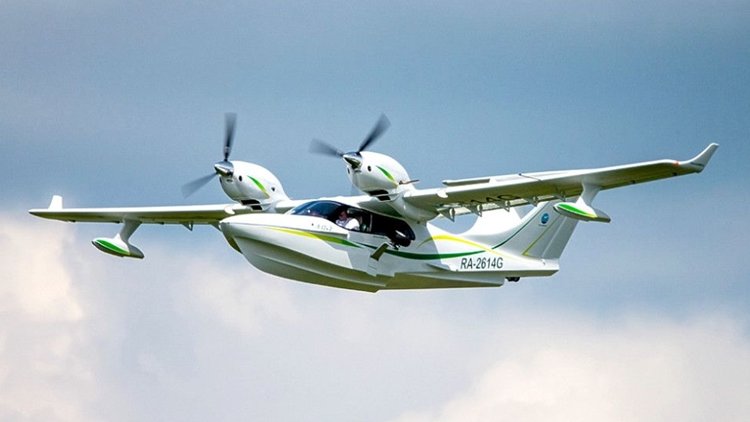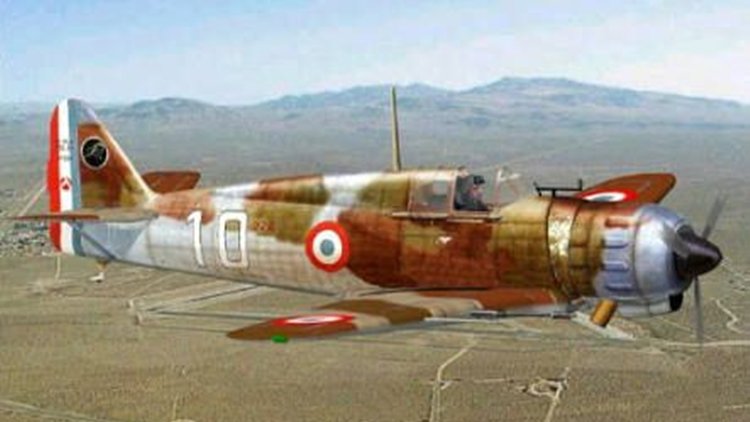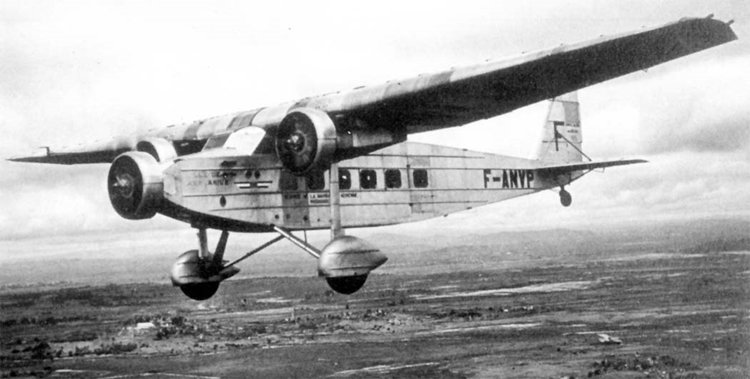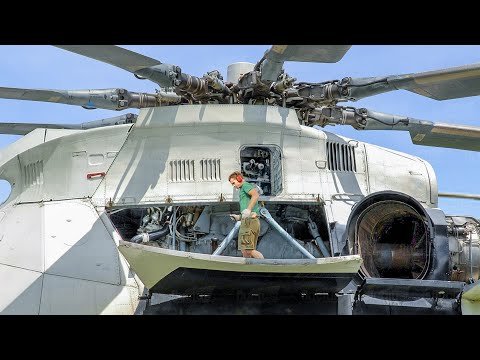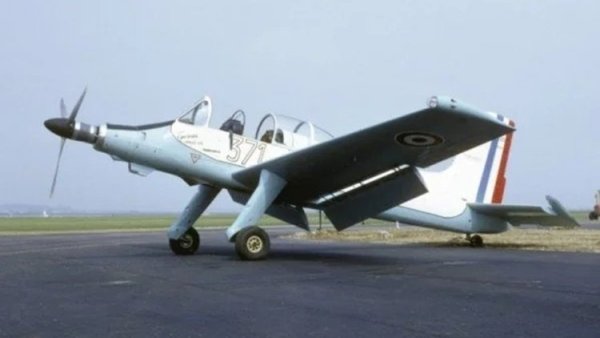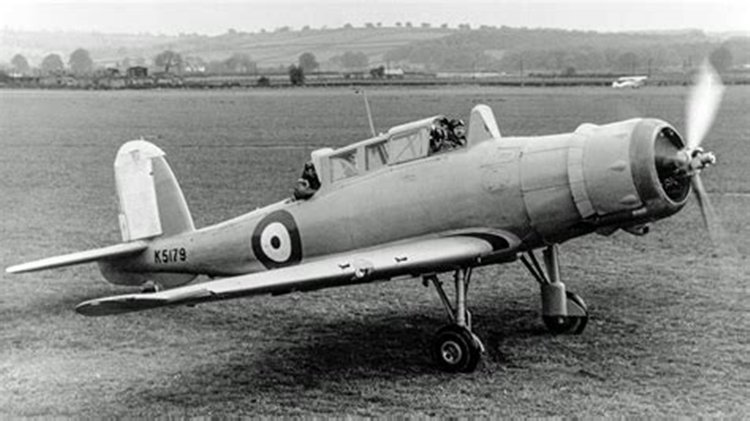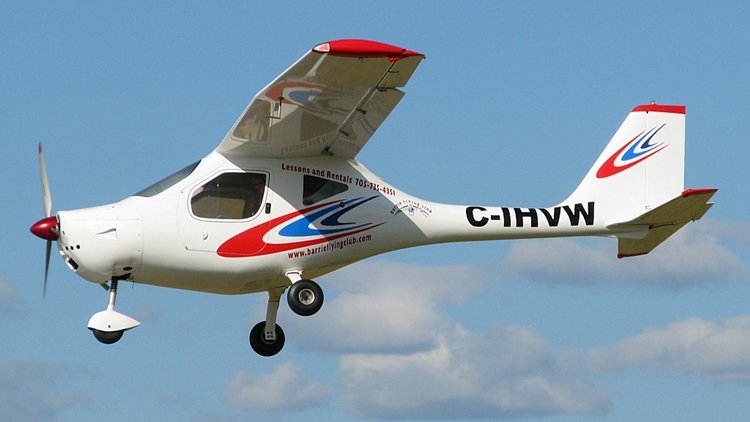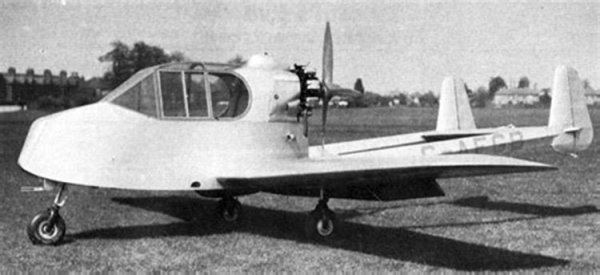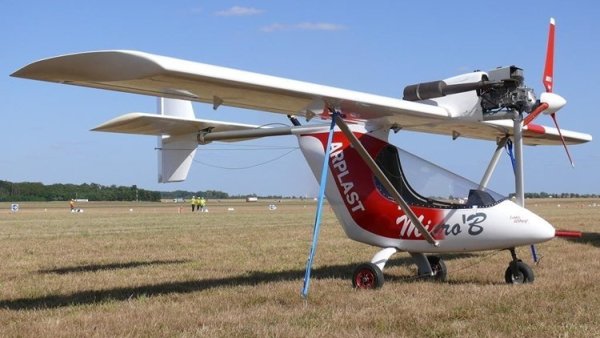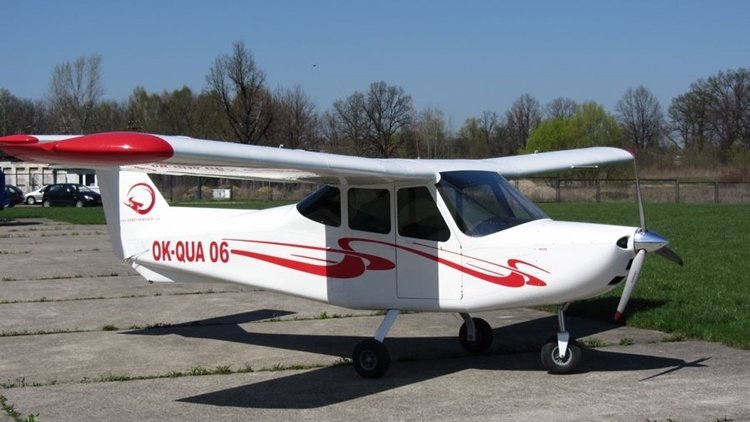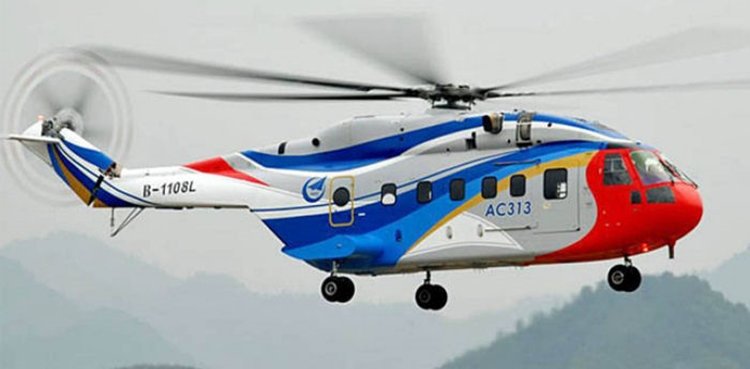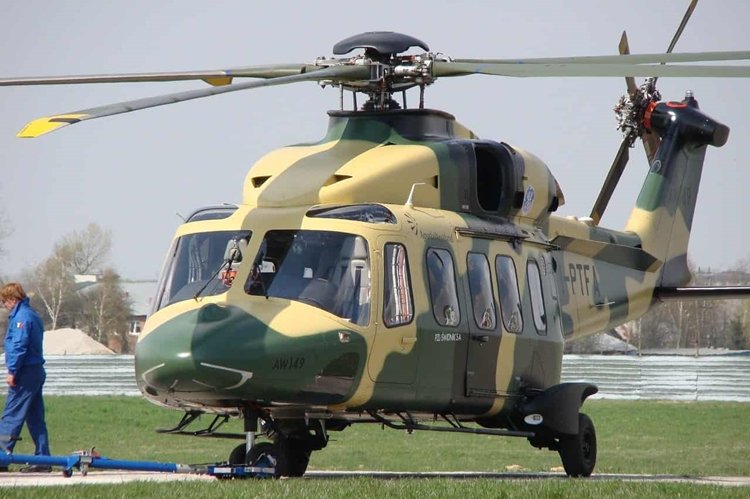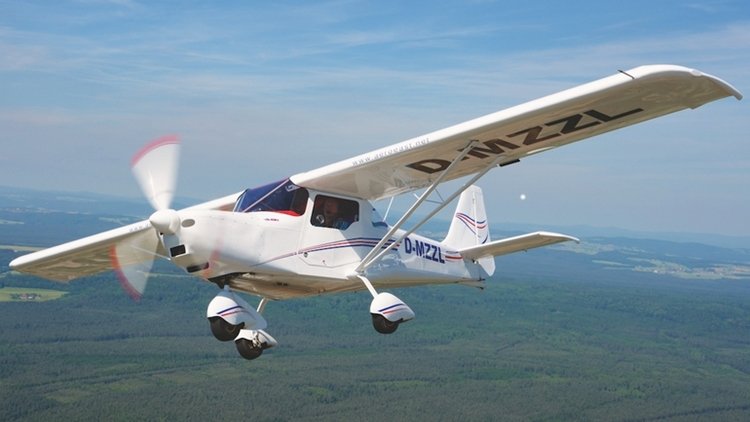-
Posts
7,736 -
Joined
-
Last visited
-
Days Won
67
Content Type
Profiles
Forums
Gallery
Downloads
Blogs
Events
Store
Aircraft
Resources
Tutorials
Articles
Classifieds
Movies
Books
Community Map
Quizzes
Videos Directory
Everything posted by red750
-
The Boeing YB-9 was the first all-metal monoplane bomber aircraft designed for the United States Army Air Corps. The YB-9 was a much enlarged twin-engine development of Boeing's single-engine Model 200 Monomail commercial transport. In May 1930, Boeing had flown its Model 200 Monomail single-engined mailplane. The Monomail was of radical design for the time, being a semi-monocoque, stressed skin cantilever monoplane with a retractable undercarriage. Air Corps bomber squadrons of the day were largely equipped with slow strut-braced biplanes built from steel-tube frames covered in doped fabric, such as the Keystone B-6, and Boeing decided to design and build a twin-engined bomber using the same techniques used in the Monomail to re-equip the Air Corps. Boeing built two prototypes of a new bomber as a private venture, which differed in the engines used, with the Model 214 powered by two liquid-cooled Curtiss V-1570-29 Conqueror engines while the Model 215 had two Pratt & Whitney R-1860 Hornet B radial engines. Both aircraft were low winged cantilever monoplanes with a slim, oval cross-section fuselage accommodating a crew of five. The pilot and co-pilot sat in separate open cockpits, with the co-pilot, who doubled as the bombardier sitting forward of the pilot. Two gunners, each armed with a single machine gun sat in nose and dorsal positions, while a radio operator sat inside the fuselage. Like the Monomail, a retractable tailwheel undercarriage was used. The first of the two prototypes to fly was the radial powered Model 215 which, carrying civil markings and the aircraft registration X-10633, made its first flight on 13 April 1931. It was leased to the Air Corps for testing under the designation XB-901, demonstrating a speed of 163 mph (262 km/h). Testing was successful, and both the XB-901 and the as-yet incomplete Model 214 were purchased as the YB-9 and Y1B-9 respectively on 13 August 1931, with an order for a further five for service testing following. The Y1B-9 (Y1 indicating funding outside normal fiscal year procurement), powered by two liquid-cooled Curtiss V-1570-29 'Conqueror' engines, first flew on 5 November 1931. The increased power from these engines, combined with improved streamlining of the engine nacelles, increased its top speed to 173 mph (278 km/h). The YB-9, meanwhile, had been re-engined with more powerful Hornet Bs, demonstrating slightly better performance than the Y1B-9, which was therefore also re-engined with Hornet Bs. The five Y1B-9A service test aircraft (Boeing Model 246) had the Pratt & Whitney R-1860-11 Hornet B engines which powered the re-engined YB-9 and Y1B-9 and a redesigned vertical stabilizer modeled on the 247D transport. While enclosed canopies were considered and designed, the B-9 was never fitted with them. Although it equaled the speed of existing American fighter aircraft, no further aircraft were built, as the Glenn L. Martin Company had flown a prototype of a more advanced bomber, the XB-907, which was ordered into production as the Martin B-10. The first of the five Y1B-9As entered service with the 20th and 49th Bombardment Squadrons, 2nd Bomb Group on 14 September 1932, with all examples built being in service by the end of March 1933. The new bomber proved impossible to intercept during air exercises in May 1932, strengthening calls for improved air defense warning systems. Two B-9s were destroyed during crashes in 1933, one of the accidents being fatal, while the remaining aircraft were gradually phased out over the next two years, with the last being withdrawn on 26 April 1935.
-
In addition to the President, staff, and flight crew, a VC-25A can carry 102 guests in typical domestic business-class seats. The back-up VC-25 typically flies with 14 crew, two pilots, six flight crew, two cooks, and four flight attendants. When transporting the President, the primary VC-25A has three cooks and 15 flight attendants, 20 or more Secret Service agents, and some 40 members of the presidential press pool. During international state visits, another aircraft may be chartered to accommodate another 150 or more journalists and security personnel.
-
The Mikoyan-Gurevich MiG-25 (Russian: Микоян и Гуревич МиГ-25; NATO reporting name: Foxbat) is a supersonic interceptor and reconnaissance aircraft that is among the fastest military aircraft to enter service. Designed by the Soviet Union's Mikoyan-Gurevich bureau, it is an aircraft built primarily using stainless steel. It was to be the last plane designed by Mikhail Gurevich, before his retirement. The first prototype flew in 1964 and the aircraft entered service in 1970. Although its thrust was sufficient to reach Mach 3.2+, its speed was limited to prevent engines from overheating at higher air speeds and possibly seriously damaging them, and therefore the operational top speed was limited to Mach 2.83. The MiG-25 features a powerful radar and four air-to-air missiles, and it still has the world record for reached altitude of 38 km (125,000 ft). The appearance of the MiG-25 sparked concern in the West and prompted increases in performance requirements for the McDonnell Douglas F-15 Eagle, then already under development in the late 1960s. The capabilities of the MiG-25 were better understood by the West in 1976 when Soviet pilot Viktor Belenko defected in a MiG-25 to the United States via Japan. Production of the MiG-25 series ended in 1984 after completion of 1,186 aircraft. A symbol of the Cold War, the MiG-25 flew with Soviet allies and former Soviet republics, remaining in limited service in several export customers. It is one of the highest-flying military aircraft,[6] one of the fastest serially produced interceptor aircraft, and the second-fastest serially produced aircraft after the SR-71 reconnaissance aircraft, which was built in very small numbers compared to the MiG-25.[8] As of 2018, the MiG-25 remains the fastest manned serially produced aircraft in operational use and the fastest plane that was offered for supersonic flights and edge-of-space flights to civilian customers. Because of the thermal stresses incurred in flight above Mach 2, the Mikoyan-Gurevich OKB had difficulties choosing what materials to use for the aircraft. They had to use E-2 heat-resistant Plexiglas for the canopy and high-strength stainless steel for the wings and fuselage. Using titanium rather than steel would have been ideal, but it was expensive and difficult to work with. The problem of cracks in welded titanium structures with thin walls could not be solved, so the heavier nickel steel was used instead. It cost far less than titanium and allowed for welding, along with heat-resistant seals. The MiG-25 was constructed from 80% nickel-steel alloy, 11% aluminium, and 9% titanium. The steel components were formed by a combination of spot welding, automatic machine welding, and hand arc welding methods. The MiG-25 was theoretically capable of a maximum speed exceeding Mach 3 and a ceiling of 27 km (89,000 ft). Its high speed was problematic: Although sufficient thrust was available to reach Mach 3.2, a limit of Mach 2.83 had to be imposed as the engines tended to overspeed and overheat at higher airspeeds, possibly damaging them beyond repair. For extensive details on background, development, operational history and 25 variants, click here.
-
The Colani Cormoran CCE208 was a five-seat light aircraft under development in Germany in the late 1980s. The highly streamlined and unusual design was the work of the aeronautical engineer Walter Schulze with the collaboration of the celebrated industrial designer Luigi Colani. A particularly unorthodox feature was the pusher propeller mounted behind the top of the T-tail. Power was to be supplied by a converted Porsche automobile engine rated at 245 horsepower. The airframe was to be largely composite construction. A mockup was displayed at the Paris Air Show in 1987. No actual aircaft built. Construction of the prototype aircraft was to have been undertaken by the Composite Engineering Company in Germany, with financial backing from Tohshin of Japan.
-
The Piper PA-47 "PiperJet" was a single-engined very light jet (VLJ) that was intended to be developed and built by Piper Aircraft. However, following a change of ownership at Piper, it was decided to redesign the aircraft as the PiperJet Altaire. Despite being technically successful, the Altaire project was canceled in October 2011 due to economic conditions. The aircraft is the first proposed single-engined civilian aircraft with a podded engine located on the tail. The PiperJet was announced in October 2006, as a competitor to the twin-engined Eclipse 500 and Cessna Citation Mustang. The aircraft's fuselage was the same cross section as the propeller-driven Piper PA-46 series, with a 4 feet (1.2 m) increase in length. It was to be capable of carrying up to 7 passengers and cruise at 360 knots (666.7 km/h), at a maximum altitude of 35,000 feet (10,668.0 m). Maximum range was expected to be 1,300 nautical miles (2,407.6 km), with a full-fuel payload of 800 pounds. Piper selected Williams International to supply its FJ44-3AP turbofan engine for the PiperJet. Due to the engine being mounted above the center of gravity, power was highly stabilizing (addition of power would push the nose down), which could have been disconcerting to pilots. Initially, Piper designers incorporated an automatic pitch trim system to coordinate horizontal stabilizer angle of incidence with power setting. This system was later replaced by a vectored thrust nozzle, developed by Williams International, which resulted in reduced weight and simplified manufacturing processes. On 18 October 2011, AVweb editor-in-chief Russ Niles called for the project to be ended, calling it "unrealistic" to pursue the design in the face of Federal Aviation Administration opposition to certifying a single engined jet to 35,000 ft (10,668 m) and the lack of economic reasoning as the aircraft would cost the same as most twin-engined jets. Niles called on Piper saying, "the sooner it ends its "review" of the project and puts a bullet in it the better." Only one prototype was built.
-
The Boeing Model 40 is a United States mail plane of the 1920s. It was a single-engined biplane that was widely used for airmail services in the United States in the 1920s and 1930s, especially by airlines that later became part of United Airlines. It became the first aircraft built by the Boeing company to carry passengers. In 1925, the US Post Office issued a requirement for a mailplane to replace the ex-military DH-4s then in use. The new aircraft was required to use the same water-cooled Liberty V12 engine as used by the DH-4, of which large stocks of war-built engines were available. The resultant aircraft, the Boeing Model 40, was a conventional tractor biplane, with the required Liberty engine housed in a streamlined cowling with an underslung radiator. The aircraft's fuselage had a steel tube structure, with an aluminum and laminated wood covering. Up to 1,000 lb (450 kg) of mail was carried in two compartments in the forward fuselage, while the single pilot sat in an open cockpit in the rear fuselage. The wings and tail were of wooden construction, and the Model 40 had a fixed conventional landing gear. The Model 40 made its first flight on July 7, 1925. Although the prototype was purchased by the US Post Office, the production order went to the Douglas M-2. The Contract Air Mail Act of 1925 set out the gradual privatization of the Post Office's Air Mail routes. In late 1926, bids were requested for the main transcontinental trunk mail route, which was to be split into eastern and western sections, with Boeing bidding for the western section. Boeing revived the design for the tender, with the Model 40A replacing the Liberty engine with a 425 hp (317 kW) air-cooled Pratt & Whitney Wasp radial engine, which was 200 lb (91 kg) lighter than the Liberty, even ignoring the weight of the Liberty's radiator and cooling water. The fuselage was redesigned to make more extensive use of welded steel tubing, and an enclosed cabin was fitted between the mail compartments, allowing two passengers to be carried as well as 1,200 lb (540 kg) of mail. Boeing's bid of $3 per lb was much less than any of the competing bids, and Boeing was awarded the San Francisco to Chicago contract in January 1927, building 24 Model 40As for the route (with a further aircraft being used as a testbed by Pratt & Whitney). The next model to reach production was the Model 40C, with an enlarged cabin allowing four passengers to be carried. Meanwhile, Boeing Air Transport's Model 40As were modified by replacing their Wasp engines with 525 hp (391 kW) Pratt & Whitney Hornet radial engines to become the Model 40B-2. The Model 40B-4 was a new-build aircraft combining the four-passenger cabin of the Model 40C with the Hornet engine of the B-2. Production continued until February 1932. Boeing's airline, Boeing Air Transport, commenced operations on the San Francisco–Chicago route on July 1, 1927. Variants Model 40 Original 1925 design with Liberty engine. Model 40A Revised 1927 design for BATC. the aircraft was powered by a Pratt & Whitney Wasp radial engine, plus seating for two passengers in an enclosed cabin; 25 built. Received Dept of Air Commerce Approved Type Certificate #2. Model 40B Model 40As re-engined with a 525 hp (391 kW) Pratt & Whitney Hornet radial piston engine. 19 Model 40A were converted. Redesignated Model 40B-2. Model 40B-4 Revised Model 40B with seating for four passengers and other improvements. Equipped with openable windows, plus seating for four passengers; 38 built. Model 40B-4A (Specifications below) One Model 40B used as engine testbed by Pratt & Whitney. Model 40H-4 Four Model 40B-4s built by Boeing Canada. Two aircraft were exported to New Zealand. Model 40C Similar to Model 40B-4 but with Pratt & Whitney Wasp engine of Model 40A. (ten built, all later converted to Model 40B-4 standard). Model 40X Unique special-order machine similar to Model 40C with only two-passenger cabin and extra open cockpit forward of pilot's cockpit. Model 40Y Unique special-order machine similar to Model 40X, but with Pratt & Whitney Hornet engine.
-
The Chaika L-4 (чайка, English: Seagull) is a twin engine amphibious aircraft, designed and built in Russia in the 2000s. It has sold in small numbers and remains in production. Several companies and groups have developed a series of designs which began at an offshoot of the Trod Kuznetsov aircraft engine plant in Samara. Beginning with the L-3, they differ in size and engine type but all are twin engine amphibians with a characteristic V tail. The L-4 is a direct development of the L-6M, promoted by AeroVolga. Its design began in August 2004. All L-4 variants have the same layout and all are largely built of composite materials. They are high-wing monoplanes with twin engines mounted close to the fuselage, on top of the wing. The wings have straight taper on both edges and almost square tips. The L-4 has a pair of flaps on each wing. Its hull has two steps and there are small winglets at waterlevel just aft of the trailing edge. The cabin extends from below the leading edge rearwards to the winglets. Fixed floats under the wings stabilize the L-4 on water; it is operable with waves to 400 mm (15 in) high. The most unusual feature of the L-4 is the empennage arrangement: it has twin fins, mounted on the fuselage and extended forward with long, curved dorsal fillets, separated at the base by the full fuselage width and leaning slightly outwards. The fins carry conventional rudders and the single tailplane is mounted upon the fin tips, extending well beyond them. Tailplane and single piece elevator together are trapezoidal; there is a trim tab at the centre of the elevator. The reason for the design is that the spine serves as a walkway to access the plane from behind, when moored at shore. The L-4 has a conventional undercarriage for land use, all three wheels and the water rudder being retractable. The first flight of the L-4 was in June 2005. The most recent variant, the more powerful L-44 flew in 2009. By mid-2008 sales, probably including L-6s from AeroVolga, had reached 14. Variants L-4 Original design, no longer produced. L-42 Improved, with Rotax 912 ULS flat four 73.3 kW (98.6 hp) engines. L-42M Further improvements: weight savings, winglets, crew ergonomics. Marketed by Aviatech1.com. L-44 More powerful Rotax 914 engines, as detailed below. First flown 2009. L-65 Improved with Rotax 915 iS engines. Improved with Rotax 915 iS engines.
-
The Bloch MB.150 (later MB.151 to MB.157) was a French fighter aircraft developed and produced by Société des Avions Marcel Bloch. It featured an all-metal construction, complete with a retractable undercarriage, low cantilever wing and a fully enclosed cockpit. The MB.150 was originally developed to conform with the requirements of the 1934 French Air Ministry competition seeking a new fighter design. Despite the competition being won by the competing Morane-Saulnier M.S.406, it was decided to proceed with development. Initially proving unable to attain flight, the modified prototype conducted its maiden flight in October 1937. Service trials of the MB.150 determined the aircraft to hold sufficient promise to warrant further work, leading to the adoption of an expanded and strengthened wing and a more refined Gnome-Rhone 14N-7 engine. During spring 1938, following the completion of further proving trials, an order for a pre-production batch of 25 aircraft was placed. Redesigns of the MB.150 design led to the improved MB.151 and MB.152 which entered squadron service with the Armée de l'Air. By the outbreak of the Second World War, around 120 aircraft had been delivered to the Armée de l'Air but most were not sufficiently equipped to be considered operational. An improved MB.155 had greater range. Ordered into production in 1940, only ten aircraft had been completed by the Fall of France. The MB.157, a further improved model with a heavier and more powerful engine, was completed during the Vichy era. Though it demonstrated promising performance, it did not enter production. On 13 July 1934, the Service Technique Aéronautique (Aeronautical Technical Service) of the French Air Force issued the "C1 design" requirement for a new and completely modern single-seat interceptor fighter. Envisioned to make use of a monoplane layout and a retractable undercarriage, the prospective fighter aircraft was to serve as a replacement for the French Air Force's existing inventory of Dewoitine D.371, Dewoitine D.500, and Loire 46 aircraft. Amongst the various aviation companies who took interest in the specification, to which the potential for a large production order was attached, was French aircraft manufacturer Société des Avions Marcel Bloch. The design team, headed by Maurice Roussel, was assembled at Bloch's Courbevoie facility in Paris. They designed an all-metal stressed skin monoplane, powered by a single 930 hp Gnome-Rhône 14Kfs radial engine and armed with a pair of wing-mounted Hispano-Suiza-built HS.404 cannon. During September 1935, construction of the type's first prototype, designated as the Bloch 150-01, commenced. Although the C.1 competition was ultimately won by a rival design, the Morane-Saulnier M.S.406, it was decided to independently continue with the design's development. During 1936, these efforts culminated in the first attempted flight of the MB.150.01 prototype; unfortunately, the aircraft proved unable to leave the ground during the attempt. In the ensuing disappointment work on the design was temporarily halted, but development was resumed during early 1937. Following the implementation of various modifications, consisting of a strengthened wing of greater area, revised undercarriage arrangement and the installation of a 701 kW (940 hp) Gnome-Rhone 14N-0 radial engine with a three-blade constant speed propeller, on 29 September 1937, the MB.150 finally conducted its maiden flight. Approximately 663 were built. For more details on development, operational history and 8 variants, continue reading here.
-
The Bloch MB.120 was a French three-engine colonial transport aircraft built by Société des Avions Marcel Bloch during the 1930s. The MB.120 design was selected by the French government for transport use in French overseas territories. It was an all-metal high-wing cantilever monoplane. The prototype was re-worked from the MB.71. Standard accommodation was for a crew of three and up to 10 passengers. The civil aircraft normally carried only four passengers, the rest of the aircraft was filled with mail. Ten production aircraft were produced, six for civil use and four for the French Air Force. The aircraft entered operation in 1934 for Air Afrique, which was a new airline set up by the French government on 11 May 1934 to provide service between the French African territories. Both the civil and military aircraft served only in French Africa. Variants MB.120.01 : First prototype. MB.120 : Three-engined colonial transport aircraft. Ten built.
-
In collaboration with the U.S. Air Force and Qatar Emiri Air Force (QEAF), Boeing has celebrated the naming and rollout of Qatar's advanced F-15 fighter jet, the F-15QA named Ababil, after the flock of birds mentioned in the Quran. “The Qatar F-15QA program further enhanced next-generation technologies in the advanced F-15 such as the fly-by-wire flight controls, an all-glass digital cockpit and contemporary sensors, radar and electronic warfare capabilities,” said Prat Kumar, vice president of the F-15 program. “Driven by digital engineering and advanced manufacturing, these aircraft represent a transformational leap for the F-15. The F-15QA will enhance the superiority of the QEAF with more speed, range and payload than any fighter in the world.”
-
The Morane-Saulnier MS.1500 Épervier (en: Sparrowhawk) was a 1950s French two-seat ground attack and reconnaissance aircraft. Designed and built by Morane-Saulnier to meet a French Air Force requirement, it did not enter production. Designed to meet a requirement for a tactical reconnaissance and counter-insurgency aircraft for use by the French Air Force in Algeria the Epervier was a tandem two-seat low-wing cantilever monoplane. Powered by a 522 kW (700 hp)) Turbomeca Bastan turboprop the MS.1500 had a fixed tailwheel landing gear. The prototype first flew on the 12 May 1958 powered by a 300 kW (402 hp)) Turbomeca Marcadau turboprop. A second prototype was built but the type did not enter production.
-
The Mitsubishi Ki-83 (キ83) was a Japanese experimental long range heavy fighter designed near the end of World War II. It did not reach production status. The Mitsubishi Ki-83 was designed as a long range heavy fighter. It was designed and built by a team led by Tomio Kubo, designer of the highly successful Mitsubishi Ki-46. The design was a response to a 1943 specification for a new heavy fighter with great range. The first of four prototypes flew on 18 November 1944. The machines displayed remarkable maneuverability for aircraft of their size, being able to execute a 671 m (2,200 ft) diameter loop in just 31 seconds at a speed of over 644 km/h (400 mph). The Ki-83 carried a powerful armament of two 30 mm (1.18 in) and two 20 mm cannon in its nose. Despite the bomb-ravaged Japanese manufacturing sector, plans for the Ki-83 to enter production were underway when Japan surrendered on 15 August 1945. Both the existence and performance of the Ki-83 were little known during the war, even in Japan. It was completely unknown in Allied military aviation circles – as demonstrated by the fact that the Ki-83 had not been given a reporting name. Most early photographs of the type were taken during the post-war occupation of Japan, when the four prototypes were seized by the United States Army Air Forces and repainted with USAAF insignia. When they were evaluated by U.S. aeronautical engineers and other experts, a Ki-83 using high-octane fuel reached a speed of 762 km/h (473 mph), at an altitude of 7,000 metres (23,000 ft). Variants Ki-83 experimental long-range heavy fighter, four prototypes built. Ki-95 projected reconnaissance version, none built. Ki-103 projected development, none built
-
The Blackburn B-24 Skua was a carrier-based low-wing, two-seater, single-radial engine aircraft by the British aviation company Blackburn Aircraft. It was the first Royal Navy carrier-borne all-metal cantilever monoplane aircraft, as well as the first dive bomber in Fleet Air Arm (FAA) service. The aircraft took its name from the sea bird which 'divebombs' any potential predators that come too close to its nest. The Skua was designed during the mid-1930s to Specification O.27/34, and was a radical design for the era, combining the functions of a dive bomber and fighter. Its enclosed cockpit and monoplane configuration were obvious shifts from preceding FAA aircraft such as the Hawker Nimrod and Hawker Osprey biplanes. On 9 February 1937, the first prototype performed its maiden flight; it was ordered straight off the drawing board to accelerate its development. In November 1938, the Skua was introduced to FAA service; 33 aircraft were operational by the outbreak of the Second World War. During the early half of the conflict, the Skua was heavily involved in the Norwegian campaign and sank the German cruiser Königsberg, the first major warship sunk in war by air attack and by dive-bombers. It was present during the Battles of Narvik, the Dunkirk evacuation and also the early stages of the Mediterranean theatre. While a capable dive bomber, its poor top speed and rate of climb meant it was severely limited as a fighter aircraft. Despite this, Fleet Air Arm pilots achieved moderate success with the Skua, scoring numerous aerial victories during the Norwegian and Mediterranean campaigns, with at least one pilot making ace status with five victories. In 1941, the Skua was relegated from frontline operations, but continued to be operated in secondary roles, typically training and target tug duties, as late as March 1945. The Blackburn Skua was configured as a low-wing cantilever monoplane of all-metal construction Its fuselage drew on the design of the Blackburn Shark, an earlier biplane, making extensive use of flush-riveted Alclad. It was internally divided into two water-tight compartments beneath the pilot's and gunner's cockpits to provide sufficient buoyancy in the event of a forcing landing at sea For the same reason, the crew compartments were also watertight up to the edges of the cockpit. The fuselage was stressed to withstand catapult-assisted takeoffs and arrested landings aboard aircraft carriers; a hydraulic damping device was incorporated in the hook. The mainplane, both the structure and covering of which was also composed of Alclad, was built as three separate units. The twin-spar heavy centre section was bolted beneath the fuselage to form the bottom of the watertight compartment. The outer wing panels, which tapered in both plan and thickness, ended in detachable upswept tips and were sealed between the main spars to form additional watertight compartments. Recesses in the lower surface of the wing accommodated modified Zap flaps that were used to shorten takeoff runs, steepen glides, and limit the aircraft's speed during steep dives. Balanced ailerons were fitted, which used inset hinges with mass balance assistance. The number built was 192. For many more details, click here.
-
The Bilsam Sky Cruiser is a Polish microlight aircraft designed and produced by Bilsam Aviation of Poznań, introduced in the early 2000s. The aircraft is supplied as a complete ready-to-fly-aircraft, as a kit and in the form of plans for amateur construction. The manufacturer's website is non-functional and has been so since about 2008, so it is not clear if the company is still in business. The aircraft was designed to comply with the Fédération Aéronautique Internationale microlight category, including the category's maximum gross weight of 450 kg (992 lb). The aircraft has a maximum gross weight of 450 kg (992 lb). With a Rotax 912 ULS engine it is an accepted US light sport aircraft and also a Transport Canada accepted Advanced Ultra-Light Aeroplane. Originally shown as a pusher configuration design in 2003, by 2004 the aircraft had been redesigned. In its production configuration the Sky Cruiser features a cantilever high-wing, a two-seats-in-side-by-side configuration enclosed cabin with doors for access, fixed tricycle landing gear with wheel pants and a single engine in tractor configuration. The aircraft is made from composite material. Its 9.0 m (29.5 ft) span wing mounts flaps and has a wing area of 10.35 m2 (111.4 sq ft). The standard engine used is the 100 hp (75 kW) Suzuki automotive conversion powerplant. The aircraft has a typical empty weight of 250 kg (550 lb) and a gross weight of 450 kg (990 lb), giving a useful load of 200 kg (440 lb). With full fuel of 60 litres (13 imp gal; 16 US gal) the payload for pilot, passenger and baggage is 157 kg (346 lb). The Sky Cruiser was redesigned by BOT Aircraft as the BOT SC07 Speed Cruiser.
-
The Bellanca 28-92 Trimotor was a racing aircraft built to compete in the Istres-Damascus-Paris Air Race of 1937, and was paid for by popular subscription in Romania. Christened Alba Julia ("White Julia", registration YR-AHA) it was piloted by Captain Alexander Papana of the Romanian Air Force . The aircraft was a low-wing cantilever monoplane with a similar fuselage to the Bellanca 28-70 and 28-90, but was fitted with three engines, one in the nose, and one in each of two underwing nacelles. The nacelles also housed the main undercarriage units when retracted. The fuselage was of tubular steel construction and covered by aluminum back to the cockpit. Aft of the cockpit, the fuselage was covered with fabric. The wings and tail were plywood-covered, and the control surfaces were covered by fabric. The main undercarriage partially retracted into the rear of the wing engine nacelles, but the tailwheel did not retract. Installed in each wing of the aircraft was a 250-HP (186 kW) Menasco C6S4 Super Buccaneer engine. The C6S4 was a direct drive, air-cooled, inverted, straight-six aircraft engine. The C6S4 was supercharged and displaced 544 cu. in. (8.9 L). Each C6S4 engine drove a 6-ft. 6 in (0.15 m) diameter, two-blade, adjustable-pitch propeller. In 1938, Bellanca re-registered the aircraft in the United States as NX2433 and entered it in the Bendix Trophy cross-country race. Frank Cordova was the pilot for the race, and the trimotor flew as race number 99. Unfortunately, because of engine trouble, the aircraft did not finish the cross-country race. The aircraft competed in the 1939 Bendix Trophy race, placing second, piloted by Arthur Bussy. After being sold in South America, the 28-92 ended its days rotting in a small field in Ecuador. Only 1 was built.
-
The Arpin A-1 was a two-seat low-wing monoplane which was powered by a single radial engine in pusher configuration, mounted behind the cabin between twin booms that carried the tail. An unconventional fixed tricycle undercarriage was fitted. Only one was built. The Arpin A-1 was a low-wing monoplane of wooden construction and plywood covered. The empennage was carried on a pair of diamond cross section booms mounted on the rear wing spar at the edge of the centre section. The fins were tall, with a slight extension below the boom and carrying unbalanced rudders. The booms were at wing height but the side by side two seat enclosed cabin sat on the wing with the uncowled 68 hp (51 kW) British Salmson AD.9R radial immediately behind, with its centre line well above the booms and tailplane. The pusher arrangement and a short nose provided good visibility from the cabin. The Arpin had a fixed tricycle undercarriage at a time when most aircraft used the tailwheel configuration. It was the first British aircraft to be designed for tricycle landing gear. In 1938 a very unusual McClaren type was fitted, which allowed all three wheels to be turned parallel to each other but not to the aircraft, so that cross wind landings could be made with the aircraft pointing into wind. The front wheel could be left to caster or could be steered by the pilot.
-
The Arplast Micro'B (English: Microbe) is a French ultralight aircraft that was designed and produced by propeller manufacturer Arplast Helice. It was supplied as a kit for amateur construction or as a complete ready-to-fly-aircraft. The Arplast Micro'B was designed to comply with the Fédération Aéronautique Internationale microlight rules, with a lightened version for the US FAR 103 Ultralight Vehicles category. It features a strut-braced high-wing, a single-seat enclosed cockpit, fixed tricycle landing gear and a single engine in tractor configuration. The Micro'B is made from a combination of welded steel and carbon fibre, with the flying surfaces made from the latter material. Its 8.6 m (28.2 ft) span wing is supported by a single strut per side and features automatic flaps. Standard engines included the 40 hp (30 kW) Rotax 447 two-stroke or other small lightweight motors, mounted on the main keel tube above the cockpit.
-
The Ameur Altania was a single-engine light aircraft of pusher configuration with side-by-side seats for two and a V-tail, designed in France in the 1990s. Several prototypes were built and flown, including a 15 m span motorglider version; the final prototype was constructed from carbon composites rather than glass fibre. Another version, the UCA Carbon Bird has been built by Universal Composite Aviation after the bankruptcy of Ameur Aviation. The Altania was designed by the Corsica-based Ameur Aviation Technologie group (AAT) as the AAT Balbuzard (Osprey in English). It was a low-wing monoplane of pusher configuration, with a single buried engine driving a propeller at the extreme rear via a long driveshaft. The engine was mounted over the wing with a dorsal shallow air intake just behind the cabin. Behind the engine the fuselage became a slender boom, terminating in a butterfly tail and two ventral strakes. The cabin seated two side by side, with a small luggage space behind, and was enclosed by a forward-hinged, single piece canopy. There was a retractable tricycle undercarriage with inward retracting mainwheels, fitted with hydraulic brakes. Five prototypes The first prototype Balbuzard flew on 9 July 1995, powered by a 60 kW (80 hp) Rotax 912. Like the next three prototypes, this aircraft had a glass fibre structure. The second prototype had an 88 kW (118 hp) Textron Lycoming O-235 engine, driving a three-blade, fixed pitch propeller, and a longer span and lower set wing fitted with winglets. The undercarriage height was also increased. This second prototype F-W(P)ARA was lost in 1997 when the propeller driveshaft failed in flight; The third prototype, similarly powered, was renamed the Baljims 1A because of copyright issues. Between them, the second and third prototypes achieved 350 hours of flight testing. The fourth prototype was a long span (15 m or 49 ft 2.5 in) motorglider, only flown for 30 hours before its development was abandoned. The fifth aircraft, the Ameur Altania prototype, was built from pre-impregnated carbon-epoxy and honeycomb, because glass fibre construction of these prototypes led to excess weight. The fuselage was single piece and the single spar wing had double-slotted flaps and upturned tips. It flew in December 2001. This fifth prototype aircraft/first Altania F-WWMU is recorded as damaged in July 2005, with no mention of repair.
-
-
The Aero-Service Panda is a Polish ultralight, designed and produced by Aero-Service Jacek Skopiński of Warsaw. The aircraft is supplied complete and ready-to-fly. The Panda was designed to comply with the Fédération Aéronautique Internationale microlight rules. It features a cantilever high-wing, a T-tail, a two-seats-in-side-by-side configuration enclosed cabin, fixed tricycle landing gear and a single engine in tractor configuration. The aircraft is made from sheet aluminum, with some parts, such as the engine cowling and wing tips made from composites. Its 8.91 m (29.2 ft) span wing employs a modified NACA 633-618 airfoil, has an area of 10.6 sq m (114 sq ft) and flaps. The cabin width is 120 cm (47 in). The Panda prototype was first flown on 28 September 2011. Reviewer Marino Boric described the design in a 2015 review as possessing visibility that "is good in all directions because of very large glassed surfaces". He also noted that it is "sold at a reasonable price". Variants Panda Standard (Specifications below) Base model powered by an 80 hp (60 kW) Rotax 912UL four-stroke powerplant.[1] Panda Sport Model powered by a 100 hp (75 kW) Rotax 912ULS four-stroke powerplant.[1] Panda Exclusive Model powered by a 100 hp (75 kW) Rotax 912ULS four-stroke powerplant plus with a Dynon glass cockpit and other options as standard.
-
The Avicopter AC313 (also known as the Changhe Z-8F-100) is a civilian helicopter built by Avicopter (AVIC Helicopter Company). It is a development of the earlier Harbin Z-8, itself a locally produced version of the Aerospatiale Super Frelon. The AC313 is an updated design based on the earlier Harbin Z-8, itself a development of the Aérospatiale Super Frelon. The prototype first flew at Jingdezhen, Jiangxi on 18 March 2010. It is designed to carry 18 passengers, has a reported maximum range of 1,050 kilometres, and a maximum takeoff weight of 13 tonnes. It is equipped with three Pratt & Whitney Canada PT6B-67A engines, the AC313 is a single-rotor helicopter with tail rotors, side-by-side pilot seating, and a non-retractable landing gear. Although based on a 1960s design, the AC313 has been developed to use composite materials for the rotor blade and titanium main rotor. Composite materials are used on 50% of the helicopter and titanium is used for the remainder. The interior comes equipped with a modern integrated digital avionics system and has a cabin height of 1.83 m and 23.5 m3 in space. Designed to carry 27 passengers and two crew in the transport role, it has also been designed to be used for VIP transport, medical evacuations, and for search and rescue operations. In terms of cargo, it can carry up to 4 tonne internally or 5 tonnes on a sling. AC313 is equipped with electronic flight instrument system. The AC313 is only the second helicopter to be able to operate in the Qinghai-Tibet Plateau, first being Sikorsky S-70C Black Hawk. The flight testing period for the 13-tonne AC313 was conducted in Hulunbuir City, Inner Mongolia, starting in January where it was tested to operate in extremely low temperatures as low as minus 46C marking the scope of Asia's largest tonnage helicopter meeting the mission requirements of the cold climate and the Earth's polar regions. The helicopter also set its speed record of 336 km per hour during the testing period. The AC313 became the first China-made aircraft authorized by China's civil aviation authority in January to fly in high-altitude regions of over 4,500 meters above the sea level. The AC313 has recently received a Type Certificate issued by the Civil Aviation Administration of China (CAAC). Following Chinese certification, the first five AC313 are to be delivered to Flying Dragon Special Aviation, in 2011, but no aircraft have been delivered yet. Avicopter has plans to certify the AC313 for sales in Europe and the United States. Xu Chaoliang, the chief designer of the helicopter, said the company has so far received 32 orders from national and international customers. Equipped with advanced instrument landing system, the helicopter can be used for disaster relief even in blizzard weather in plateau regions. CAIH, a wholly owned subsidiary of the China Aviation Industry Corp, is expected to produce 300 helicopters annually by 2015, making it one of the major helicopter suppliers in the world. Headquartered in Tianjin, the company is mainly engaged in the research and development, production, maintenance and sales of helicopters and other aircraft and aviation components. Variants AC313 Commercial helicopter model derived from Changhe Z-8F. AC313A Improved AC313 with significant structural redesign, with enlarged internal load area similar to that of Changhe Z-8L. Maiden flight on 17 May 2022.
-
The AgustaWestland AW149 is a medium-lift multi-role military helicopter developed by AgustaWestland, now Leonardo, launched in 2006 and had its first flight in 2009. By 2014 it had received military flight certification, and it went on to enter production going into military service with Egypt and Thailand. It is also planned for Poland with a new PZL-Swidnik production line there that opened in 2024, and North Macedonia has a pending order. The aircraft the only contender for the British NMH procurement program in the 2020s. The AW149 began life as an all-new, military design. [1] It was unveiled at the 2006 Farnborough Air Show, with a larger fuselage and more powerful engines compared to the AW139, resulting in a greater cargo volume and payload carrying ability. On 13 November 2009, the first prototype conducted its first flight from AgustaWestland's Vergiate manufacturing facility in northern Italy. On 26 February 2011, the second prototype, the first with production model engines, made its first flight from Vergiate. On 20 June 2011 AgustaWestland announced the AW189, a civilian development of the AW149, for service in 2013. For operational history and operators, click here.
-
The Aero East Europe Sila (English: force, power or strength and also short for Serbian industry light aircraft) is a family of Serbian ultralight and light aircraft, designed and produced by Aero East Europe of Kraljevo and later of Jagodina, introduced at the AERO Friedrichshafen show in 2013. The design is supplied complete and ready-to-fly. The Sila 450 C was designed to comply with the Fédération Aéronautique Internationale microlight rules, while the larger aircraft in the family fit into the EASA CS-VLA category. All feature a V-strut-braced high-wing, an enclosed cabin, fixed tricycle landing gear and a single engine in tractor configuration. Reviewer Marino Boric described the design in a 2015 review as "very robust". Variants Sila 450 C (Specifications below) Two seat "Cruiser" model, with a semi-monocoque structure made from aluminium sheet and a maximum take-off weight of 450 kg (990 lb). Its 9.4 m (30.8 ft) span wing employs a NACA 5417 airfoil, has an area of 11.94 m2 (128.5 sq ft) and flaps. Standard engines available are the 80 hp (60 kW) Rotax 912UL, 100 hp (75 kW) Rotax 912ULS and the 115 hp (86 kW) Rotax 914 four-stroke powerplants. German LTF-UL and Serbian ultralight certified. Sila 750 C Two seat "Cruiser" model, with a semi-monocoque structure made from aluminium sheet and a maximum take-off weight of 750 kg (1,650 lb). Its 9.47 m (31.1 ft) span wing employs a NACA 5417 airfoil, has an area of 11.94 m2 (128.5 sq ft) and flaps. Standard engines available are the 100 hp (75 kW) Rotax 912ULS, the 115 hp (86 kW) Rotax 914 and the 160 hp (119 kW) Lycoming O-320 four-stroke powerplants. The aircraft is undergoing EASA CS-VLA and Serbian certification. Sila 750 S Two seat STOL model with full-span Junkers flaperons and a maximum take-off weight of 750 kg (1,650 lb). Sila 750 MT Three seat Medical Transport model, with a semi-monocoque structure made from aluminium sheet and steel tubing and a maximum take-off weight of 750 kg (1,650 lb). Its 10 m (32.8 ft) span wing employs a NACA 65-018 airfoil, full-span Junkers flaperons, has an area of 14.30 m2 (153.9 sq ft). Standard engines available are the 100 hp (75 kW) Rotax 912ULS, the 115 hp (86 kW) Rotax 914 and the 160 hp (119 kW) Lycoming O-320 four-stroke powerplants. The aircraft is undergoing EASA VLA and Serbian certification. Sila 950 Four seat model, with a maximum take-off weight of 950 kg (2,090 lb). Standard engines available are the 115 hp (86 kW) Rotax 914 and the 160 hp (119 kW) Lycoming O-320 four-stroke powerplants. The aircraft is no longer advertised on the company website.



